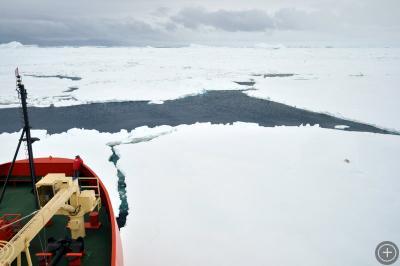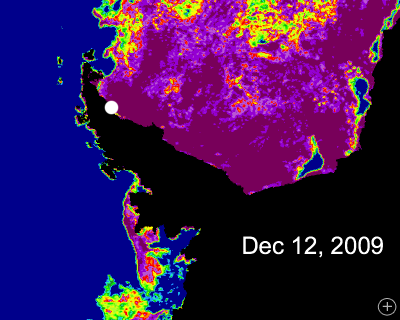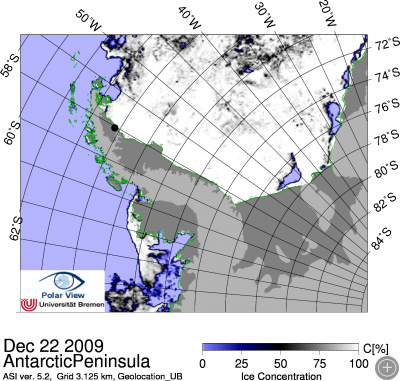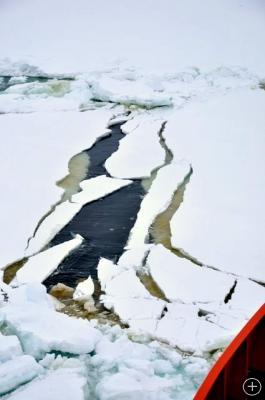When an Icebreaker Meets Its Match
ABOARD THE RVIB N. B. PALMER, ON THE WEDDELL SEA– After making our way through the Antarctic Sound at the tip of the Antarctic continent we proceeded south where after a bit of searching we recovered the whale bone lander. As whales die their carcass often sinks to the bottom of the ocean, providing an important source of food to the deep sea. These whale falls are rapidly colonized by a thriving community which include sea stars, annelid worms, hagfish, and other scavengers. Dr. Craig Smith’s mooring provides a controlled way of studying the organisms that specifically colonize whale bones, feeding on the oils and other compounds they contain. Processing those samples, which involves carefully picking off all organisms and sometimes cutting the bone itself, will take days, and as you can imagine will be one smelly job (enough that the rest of us on the ship knows what is happening).
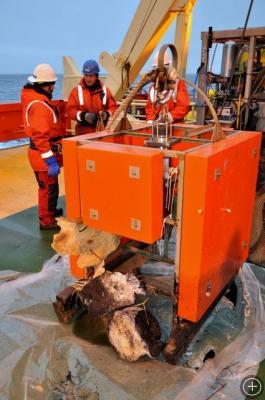
The bone lander after recovering it on the back deck of the ship. The attached whale bones will be removed and analyzed by Dr. Craig Smith and colleagues to see what animals, big and small, have made these bones their home.
While the deep sea below the euphotic zone (the top 100 or so meters, or 300 ft, where light penetrates and primary production from algae occurs) was long thought as a vast oceanic desert where few organisms (even microbes) could survive, research in the last century starting with the Challenger Expedition between 1872-1876 has shown a rich diversity of marine life specialized to face the harsh conditions of high pressure, cold temperature, and complete darkness. One of these, the annelid worm Osedax, has developed the ability to feed on complex hydrocarbons in whale bones, using bacterial endosymbionts (bacteria living inside the worms) to break down the compounds inside the bones into a usable form of energy.
As luck or fate would have it, the sea ice around Antarctica seems to be unusually persistent this year, reaching far beyond its usual summer extent, which makes moving forward a slow going process. For those of you living in cold regions of the United States and the world, you might be used to seeing your lakes and rivers freeze and thaw as the seasons progress. Sea ice around the Antarctic goes through much of the same cycle, building during the winter (between April and September in the Southern Hemisphere) and melting during the summer. The extent of ice any given year is related to weather as well as global climate, and has been shown to decrease around the Antarctic Peninsula over the past 60 years.
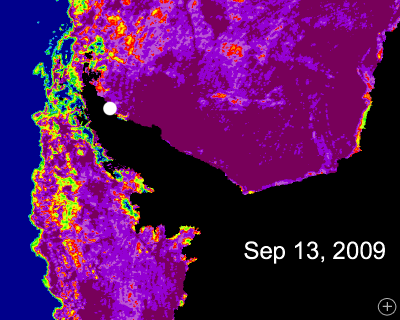
Sea ice extent in September (austral winter) of 2009 as measured by satellite. Black corresponds to land, blue to open water, and the other colors to sea ice. The approximate location of the Larsen B ice shelf, our target, is indicated by a white circle. Notice the band of purple surrounding that location, indicating persistent sea ice.
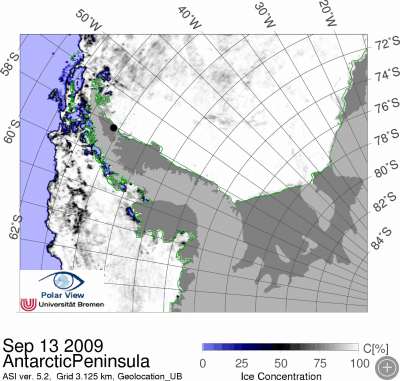
Here’s another view of the same data. In this version, grey corresponds to land, blue to open water, and white to sea ice. The approximate location of the Larsen B ice shelf, our target, is indicated by a black circle.
Because the Antarctic serves as home to a rich assemblage of species, including fish, seals, sea birds, whales, and penguins, you can imagine that life doesn’t simply stop in the cold polar winter… it adapts. Algae, which you may think as growing only in bodies of water such as lakes, oceans, and rivers, can also grow on the underside and inside of sea ice. If you look at the picture of our ship’s track you’ll notice a surprising brown color to the normally white or bluish ice. This color is due to ice algae, which due to their adaptation to low light conditions thrive both in the summer and winter. Ice algae may play an important role in starting the phytoplankton blooms that are common in the ocean as the ice retreats in the spring. Because it grows in such great abundance it also provides an important source of food to higher trophic levels, include the krill that whales love to eat. So in a way, what happens on the often hidden underside of ice can have a great impact on the bigger Antarctic animals we all know and love!

 No comments
No comments 